Netgear orporated 16400356 AC1900 WiFi VDSL/ADSL Modem Router User Manual
Netgear Incorporated AC1900 WiFi VDSL/ADSL Modem Router
User Manual
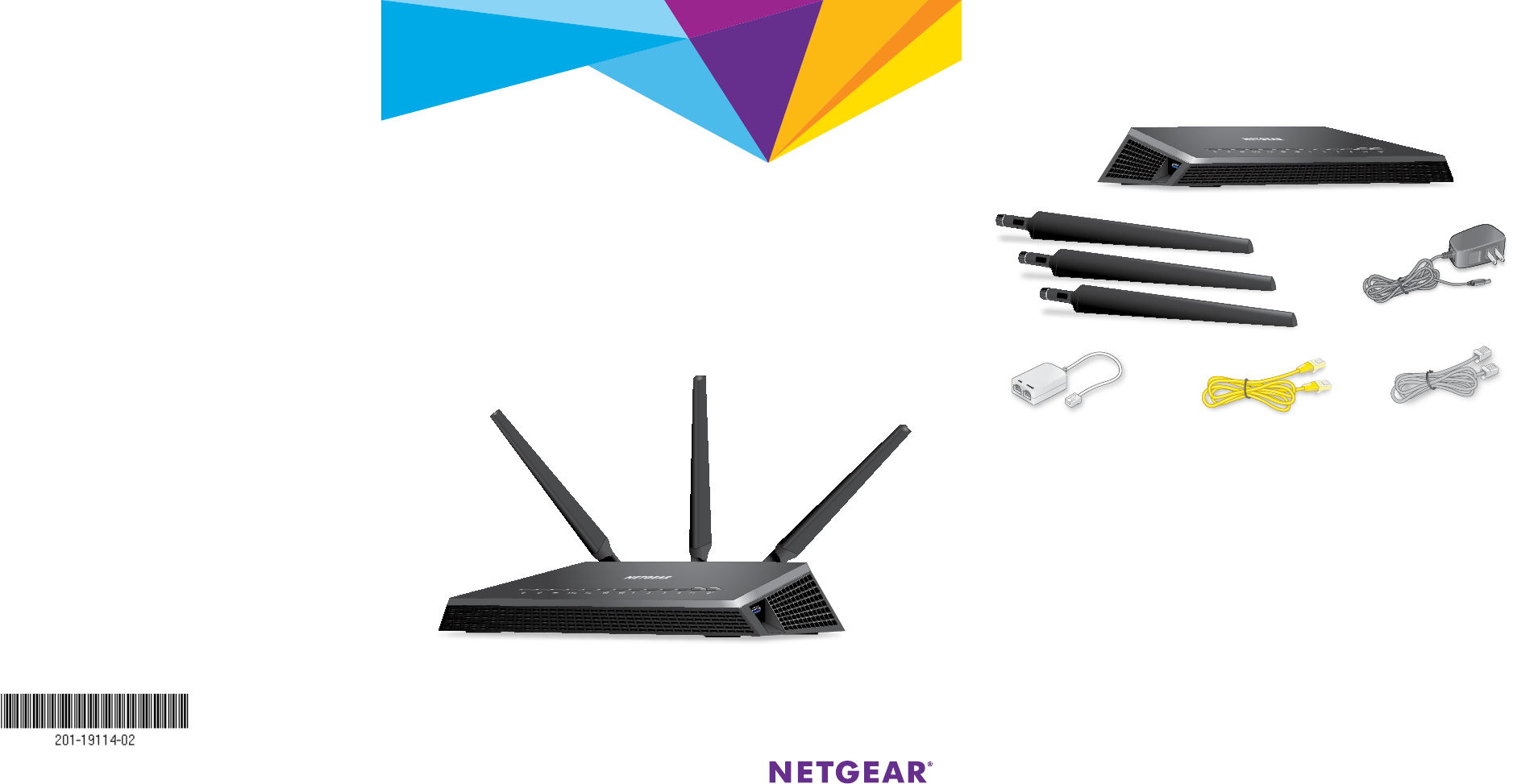
Quick Start
Nighthawk
AC1900 WiFi VDSL/ADSL Modem Router
Model D7000
Support
Thank you for purchasing this NETGEAR product. You can visit www.netgear.com/support to
register your product, get help, access the latest downloads and user manuals, and join our
community. We recommend that you use only ocial NETGEAR support resources.
Trademarks
© NETGEAR, Inc., NETGEAR and the NETGEAR Logo are trademarks of NETGEAR, Inc.
Any non‑NETGEAR trademarks are used for reference purposes only.
Compliance
For the current EU Declaration of Conformity, visit
http://support.netgear.com/app/answers/detail/a_id/11621/.
For regulatory compliance information, visit
http://www.netgear.com/about/regulatory/.
See the regulatory compliance document before connecting the power supply.
Package Contents
The box contains the following items.
In some regions, a resource CD is included in the package.
NETGEAR, Inc.
350 East Plumeria Drive
San Jose, CA 95134 USA
November 2015
Modem router
Ethernet cable
Power adapter
(varies by region)
Antennas (3)
DSL microfilter
(varies by region)
Phone cable
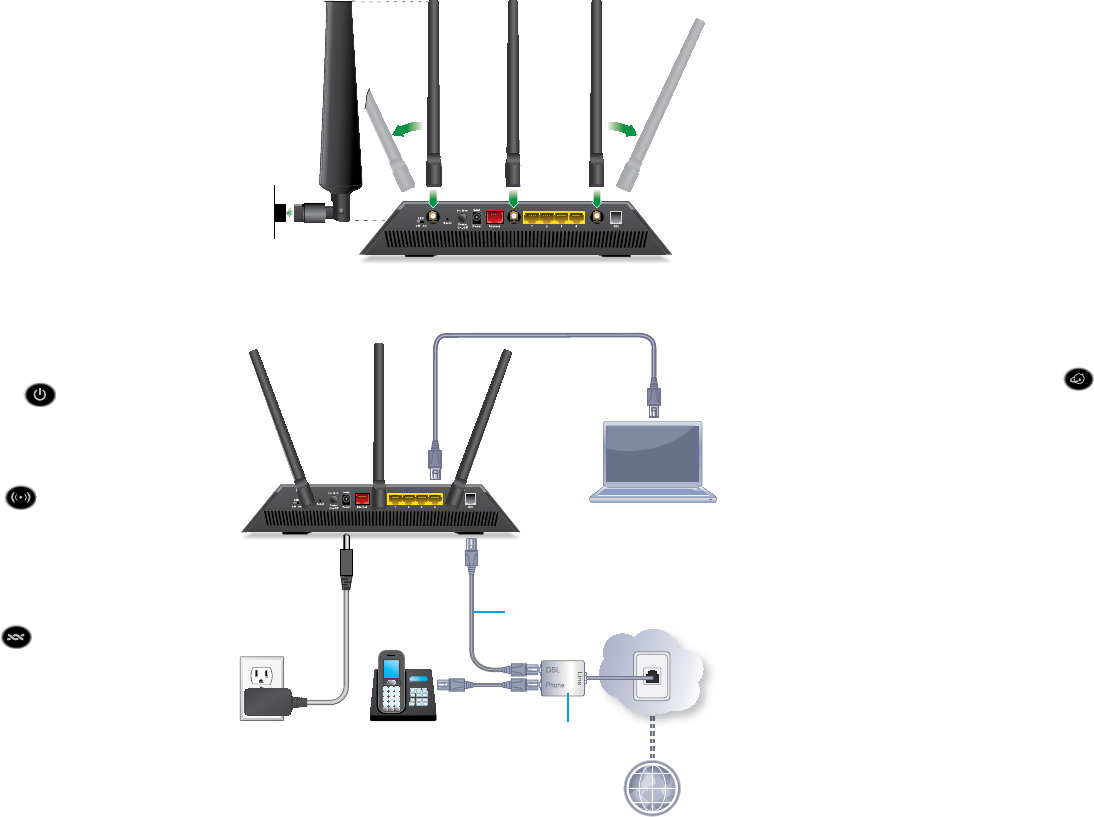
1. Attach the antennas.
Attach the antennas on the threaded antenna
posts.
Position the antennas as shown.
2. Connect the modem router to a DSL
service (ADSL or VDSL).
Install the DSL microfilter between the phone
line and the phone. Use the phone cable to
connect the DSL microfilter to the DSL port on
the modem router.
3. Power on the modem router.
Wait for the Power LED to light white.
If the Power LED does not light, press the
Power On/Off button.
Wait for the WiFi LED to light white.
4. Check the DSL LED.
If the modem router is connected to a DSL
service, the DSL LED lights white.
5. Connect a device.
You can use an Ethernet cable or connect with
WiFi.
To connect with WiFi, use the pre‑assigned
WiFi network name and password on the label
on the modem router.
6. Connect to the Internet.
Launch a web browser. The NETGEAR
installation assistant displays.
If you do not see the NETGEAR
installation assistant,
enter www.routerlogin.net in the
address field of the web browser. If a
login window displays, enter admin for
the user name and password for the
password.
The NETGEAR installation assistant
determines your Internet connection. If
the modem router successfully connects
to the Internet, the Internet LED
lights white.
7. Get the genie app.
Download the free genie app from
www.NETGEAR.com/genie.
Easily share media, files, and printers
on the network from your smartphone,
tablet, or laptop.
ADSL or VDSL
Internet
Power
adapter
You can use this diagram to connect your modem router or follow the detailed instructions in this booklet.
DSL
microfilter
Ethernet cable
Phone cable
Modem
router
8. Get the user manual.
You can get the user manual online at
http://downloadcenter.netgear.com
or through a link in the product’s user
interface.
Computer
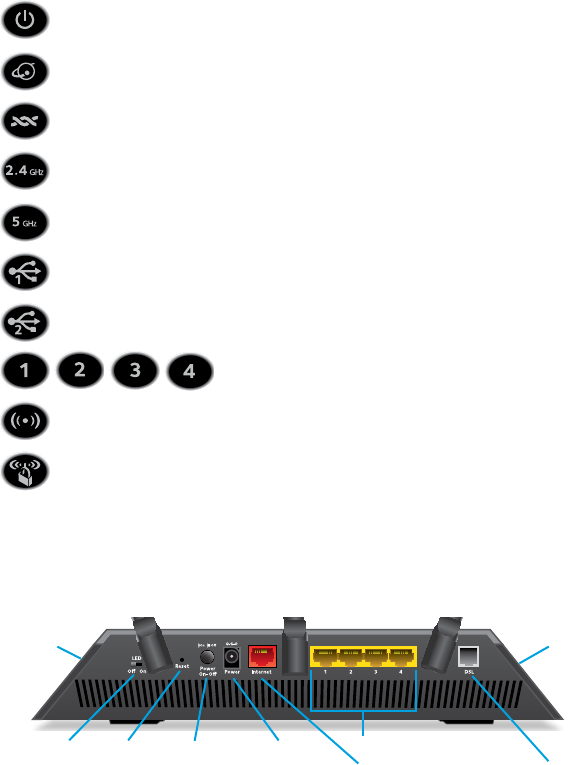
1
LEDs
The LEDs on the top of the modem router light to indicate
modem router activity:
Power
Internet
DSL
2.4 GHz WiFi
5 GHz WiFi
USB 3.0 port 1
USB 3.0 port 2
Ethernet ports 1–4
WiFi On/Off button with LED
WPS button with LED
Rear Panel
The connections and buttons on the rear panel of the
modem router are shown in the following figure:
Internet port
Reset
button
Power
On/O
button
Power
connector DSL port
Ethernet ports 1–4
LED O/On
switch
USB 3.0
port 1
USB 3.0
port 2
2
Additional Information for DSL Service
Make sure that your DSL service (ADSL or VDSL) is active before
you install the modem router. You need the following information to
install your modem router and connect to the Internet:
• DSL user name and password. This information is included
in the welcome letter your DSL Internet service provider (ISP)
sent you when you signed up for your service.
• Your telephone number or DSL account number. If you do
not use voice service, you can use your DSL account number
instead.
If you do not know or cannot locate your DSL user name and
password, call your DSL ISP.
Note: If your provider says that they do not support NETGEAR
services, tell them that you need only your DSL user name and
password; you do not need support.
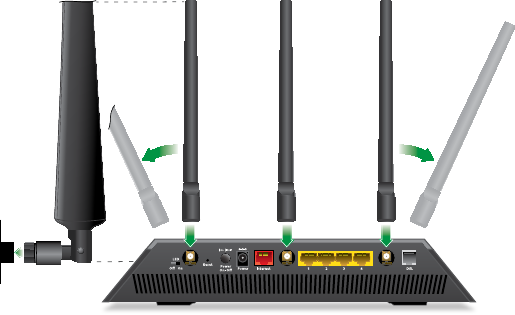
3
Install Your Modem Router
Make sure that your Internet service is active before you install
your modem router.
¾To install your modem router:
1. Attach the antennas.
a. Align the antennas with the antenna posts on the
modem router.
b. Attach the antennas on the threaded antenna posts.
c. Position the antennas as shown.
We recommend that the center antenna be vertical and
that you aim the others outward at 45‑degree angles as
shown.
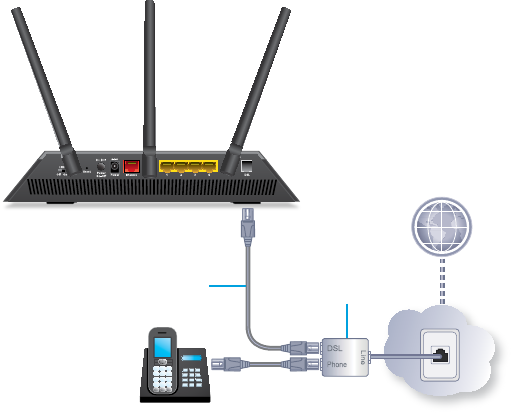
4
2. Connect the modem router to a DSL service (ADSL or VDSL).
a. Install the DSL microfilter between your phone line and a
phone.
b. Use the phone cable to connect the microfilter to the DSL
port on the modem router.
ADSL or VDSL
Internet
DSL
microfilter
Modem router
Phone cable
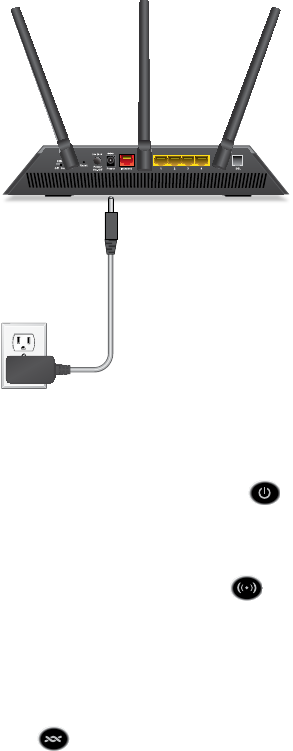
5
3. Add power to the modem router:
a. Connect the power adapter to the modem router and plug
the power adapter into an outlet.
b. Wait for the Power LED to light white.
If the Power LED does not light, press the Power On/Off
button.
c. Wait for the WiFi LED to light white.
If the WiFi LED does not light, press the WiFi On/Off
button.
4. Check the DSL LED.
If the modem router is connected to a DSL service, the DSL
LED lights white.
Modem router
Power
adapter
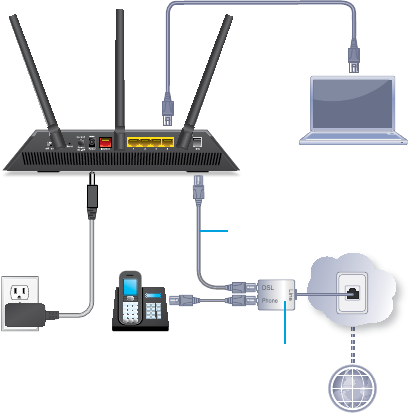
6
5. Connect a device.
You can use a wired connection to connect a computer to the
modem router, or you can use a WiFi connection to connect a
computer or WiFi device to the modem router:
• To connect using a wired connection, use an Ethernet
cable (not included) to connect an Ethernet port on your
computer to an Ethernet port on the modem router.
• To connect using a WiFi connection, find the
modem router’s pre‑assigned WiFi network name and
password on the label on the modem router. Open the WiFi
connection manager on your computer or WiFi device,
find the modem router’s WiFi network name and use the
modem router’s password to connect.
Modem
router
Power
adapter
ADSL or VDSL
Internet
DSL microfilter
Phone cable
Ethernet cable
Computer

7
6. Connect to the Internet.
Launch a web browser to log in to the modem router.
The first time that you connect to the modem router, the
NETGEAR installation assistant displays. Follow the steps on the
page to connect to the Internet.
If the NETGEAR installation assistant does not display, try the
following:
• Close and reopen the browser.
• Make sure that your computer is connected to one of the
four Ethernet ports on the modem router, or that you are
connected to the modem router’s WiFi network.
• Make sure that the modem router is receiving power and
that its Power LED is lit.
• If your computer is set to a static or fixed IP address (this
is uncommon), change it to obtain an IP address from the
modem router automatically.
If you still do not see the NETGEAR installation assistant, log in
to the modem router so that the NETGEAR installation assistant
can detect your Internet connection.
¾To log in to the modem router:
1. Launch a web browser.
2. Enter www.routerlogin.net in the address field of the
browser.
A login window displays.
3. Enter admin for the user name and password for the
password.
The BASIC Home page displays. If your Internet connection is
not set up yet, the NETGEAR installation assistant automatically
detects your Internet connection.
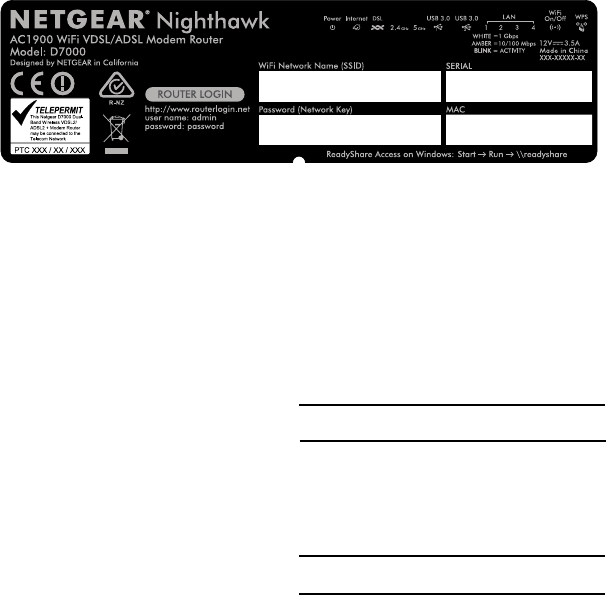
8
WiFi Network Name and Password
The preset WiFi network name (SSID) and password (network key)
are unique to your modem router, like a serial number. Because the
modem router automatically uses WiFi security, you don’t need to
set it up. The WiFi settings are on the label.
We recommend that you use the preset WiFi settings because you
can check the label if you forget them. You can also log in to the
modem router to change these settings. If you do so, write down
the new WiFi settings and store them in a safe place.
You can write the WiFi settings from the label on your
modem router in this space for easy reference.
WiFi network name (SSID):
Network key (password):
If you change the WiFi settings, write the new settings here for
easy reference and store this booklet in a safe place.
WiFi network name (SSID):
Network key (password):
9
Join the WiFi Network
You can either use Wi‑Fi Protected Setup (WPS) or select your WiFi
network and type its password. For help with the WPS button on
your computer or WiFi device, check the instructions or online help
that came with that computer or device. Some older equipment
cannot use WPS.
¾To join the network using WPS:
1. Press the WPS button on the modem router for 3–5 seconds.
The WPS LED on the modem router blinks white.
2. Within two minutes, on your computer or WiFi device, press its
WPS button or click its onscreen WPS button.
The WPS LED on the modem router lights solid white when the
computer or WiFi device connects to your modem router.
3. Repeat this process to add other computers or WiFi devices.
¾To select your network and enter its password:
1. On the computer or WiFi device, open the WiFi network
manager that manages your WiFi connections.
The WiFi network manager scans for WiFi networks in your
area.
2. Find and select your modem router’s WiFi network name (SSID).
The SSID is on the label on the modem router.
3. Enter the modem router’s password (or your custom password
if you changed it) and click the Connect button.
The password is on the label on the modem router.
4. Repeat Step 1 through Step 3 to add other computers or WiFi
devices.
10
View or Change the Modem Router
Settings
After you use the NETGEAR installation assistant to set up the
modem router, you can log in to the modem router to view or
change its settings.
Log In to the Modem Router
¾To log in to the modem router:
1. Connect a computer or WiFi device to the modem router.
You can use an Ethernet cable or connect with WiFi:
• To connect using a wired connection, use an Ethernet
cable (not included) to connect an Ethernet port on your
computer to an Ethernet port on the modem router.
• To connect using a WiFi connection, find the
modem router’s pre‑assigned WiFi network name and
password on the label on the modem router. Open the WiFi
connection manager on your computer or WiFi device,
find the modem router’s WiFi network name and use the
modem router’s password to connect.
2. Launch a web browser.
3. Enter www.routerlogin.net in the address field of the
browser.
A login page displays.
4. Enter admin for the user name and password for the
password.
The BASIC Home page displays.
11
Change the admin Password
¾To change the admin password:
1. Launch a web browser.
2. Enter www.routerlogin.net in the address field of the
browser.
A login window displays.
3. Enter admin for the user name and password for the
password.
The BASIC Home page displays.
4. Select ADVANCED > Administration > Set Password.
The Set Password page displays.
5. Type your old password and type the new password twice.
6. To be able to recover the password, select the Enable
Password Recovery check box.
We recommend that you enable password recovery.
7. Select two security questions and provide answers to them.
8. Click the Apply button.
Your changes are saved.
12
Recover a Forgotten admin Password
The default password for the admin user name is password. If you
changed the password and enabled the password recovery feature,
you can retrieve this password.
¾To retrieve a forgotten admin password:
1. Launch a web browser.
2. Enter www.routerlogin.net in the address field of the
browser.
A login window displays.
3. Click the Cancel button.
If password recovery is enabled, you are prompted to enter the
serial number of the modem router. The serial number is on the
label on the modem router.
4. Enter the serial number of the modem router.
5. Click the Continue button.
A page displays requesting the answers to your security
questions.
6. Enter the saved answers to your security questions.
7. Click the Continue button.
A page displays your recovered password.
8. Click the Login again button.
A login window displays.
9. With your recovered password, log in to the modem router.
13
Find a Forgotten WiFi Security Password
The preset WiFi password is on the label on the modem router. If
you changed your WiFi password and forgot what it is, log in to the
modem router to view its current WiFi password.
¾To connect to the modem router and view its WiFi
password:
1. Launch a web browser.
2. Enter www.routerlogin.net in the address field.
A login window displays.
3. Enter the modem router user name and password.
The default user name is admin and the default password is
password. You can use the default credentials if you did not
change them.
The BASIC Home page displays.
4. Select Wireless Settings.
The Security Options section of the page displays your WiFi
password.
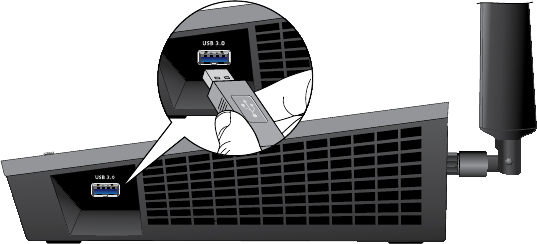
14
Share USB Devices on the WiFi Network
ReadySHARE lets you access and share USB storage devices
connected to the modem router. (If your storage device uses
special drivers, it is not compatible.)
¾To access the USB device from a Windows computer:
1. Connect your USB storage device to a USB port on the
modem router.
2. If your USB storage device uses a power supply, connect it.
You must use the power supply when you connect the USB
storage device to the modem router.
When you connect the USB storage device to the
modem router’s USB port, it might take up to two minutes
before it is ready for sharing. By default, the device is available
to all computers on your local area network (LAN).
3. On a Windows computer that is connected to the network,
select Start > Run, enter \\readyshare in the dialog box, and
click the OK button.
A window displays the files and folders on the device.
15
¾To access the USB device from a Mac:
1. Connect your USB storage device to a USB port on the
modem router.
2. If your USB storage device uses a power supply, connect it.
You must use the power supply when you connect the USB
storage device to the modem router.
When you connect the USB storage device to the
modem router’s USB port, it might take up to two minutes
before it is ready for sharing. By default, the device is available
to all computers on your local area network (LAN).
3. On a Mac that is connected to the network, launch Finder and
select Go > Connect to Server.
The Connect to Server window displays.
4. Enter the smb://readyshare in the Server Address field and
click the Connect button.
5. When prompted, select the Guest radio button.
If you set up access control on the modem router and you
allowed your Mac to access the network, select the Registered
User radio button and enter admin for the name and
password for the password. For more information about access
control, see the user manual, which is available online at
http://downloadcenter.netgear.com or through a link in the
modem router’s user interface.
6. Click the Connect button.
A window displays the files and folders on the device.
16
Back Up With ReadySHARE Vault
Your modem router comes with free backup software for all the
Windows computers in your home. Connect a USB hard disk drive
(HDD) to the modem router for centralized, continuous, and
automatic backup.
Note: The following operating systems support ReadySHARE Vault:
• Windows XP SP3
• Windows 7
• Windows 8
• Windows 8.1
• Windows 10
¾To back up your Windows computer:
1. Connect a USB HDD to the appropriate port on the
modem router.
2. Download ReadySHARE Vault from
www.netgear.com/readyshare and install it on each Windows
computer.
3. Launch ReadySHARE Vault.
The ReadySHARE Vault dashboard displays.
4. Use the dashboard or the Backup tab to set up and run your
backup jobs.
17
Share a USB Printer
You can connect a USB printer to a USB port on the modem router
and print wirelessly.
¾To set up ReadySHARE Printer:
1. Connect the USB printer to a USB port on the modem router
with a USB printer cable.
2. On each computer that will share the printer, do the following:
a. Install the current USB printer driver software (available
from the printer manufacturer).
b. Download the NETGEAR USB Control Center utility from
www.netgear.com/readyshare and install it.
c. Select the language.
3. If prompted, select the printer and click the Connect button
for each computer.
When the first computer connects, the status changes to
Manually connected by xxx.
For each computer, when you complete Step 3, the printer
status displays as Available.
18
Download the NETGEAR genie App
The free NETGEAR genie app lets you easily monitor, connect, and
control your home network from a Windows or Mac computer,
tablet, or smartphone. You can share and stream music or videos,
diagnose and repair network issues, set up parental controls, and
more:
• Access your modem router and change its settings or diagnose
and repair network issues.
• Make a printer AirPrint compatible so that you can print from
an iPad or iPhone.
• Use MyMedia to find and play media files in your network.
• Use Turbo Transfer to quickly send files from your computer or
smartphone to another device on the network.
• Set up parental controls.
• Connect your smartphones and tablets to your home WiFi by
scanning the WiFi QR code from genie.
Download the free genie app from www.NETGEAR.com/genie.
19
Federal Communication Commission Interference Statement
This device complies with Part 15 of the FCC Rules. Operation is
subject to the following two conditions: (1) This device may not cause
harmful interference, and (2) this device must accept any
interference received, including interference that may cause
undesired operation.
This equipment has been tested and found to comply with the limits
for a Class B digital device, pursuant to Part 15 of the FCC Rules.
These limits are designed to provide reasonable protection against
harmful interference in a residential installation. This equipment
generates, uses and can radiate radio frequency energy and, if not
installed and used in accordance with the instructions, may cause
harmful interference to radio communications. However, there is no
guarantee that interference will not occur in a particular installation.
If this equipment does cause harmful interference to radio or
television reception, which can be determined by turning the
equipment off and on, the user is encouraged to try to correct the
interference by one of the following measures:
- Reorient or relocate the receiving antenna.
- Increase the separation between the equipment and receiver.
- Connect the equipment into an outlet on a circuit different from
that
to which the receiver is connected.
- Consult the dealer or an experienced radio/TV technician for help.
FCC Caution: Any changes or modifications not expressly approved by
the party responsible for compliance could void the user's authority to
operate this equipment.
This transmitter must not be co-located or operating in conjunction
with any other antenna or transmitter.
For operation within 5.15 ~ 5.25GHz frequency range, it is restricted
to indoor environment.
Radiation Exposure Statement:
This equipment complies with FCC radiation exposure limits set forth
for an uncontrolled environment. This equipment should be installed
and operated with minimum distance 25cm between the radiator &
your body.
20